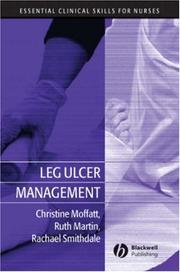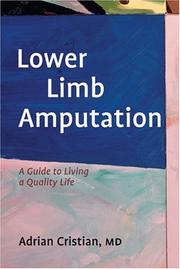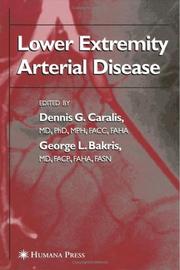| Listing 1 - 10 of 26 | << page >> |
Sort by
|

ISBN: 9781405134767 Year: 2007 Publisher: Oxford Blackwell
Abstract | Keywords | Export | Availability | Bookmark
 Loading...
Loading...Choose an application
- Reference Manager
- EndNote
- RefWorks (Direct export to RefWorks)
Leg --- Extremities, Lower --- Extremity, Lower --- Legs --- Limb, Lower --- Limb, Pelvic --- Lower extremities --- Lower extremity --- Lower limb --- Lower limbs --- Pelvic limb --- Pelvic limbs --- Extremities (Anatomy) --- Ulcers&delete& --- Nursing --- Ulcers

ISBN: 128197501X 9786611975012 1934559237 1423769104 9781423769101 9781934559239 1932603247 Year: 2006 Publisher: New York Demos Medical Pub.
Abstract | Keywords | Export | Availability | Bookmark
 Loading...
Loading...Choose an application
- Reference Manager
- EndNote
- RefWorks (Direct export to RefWorks)
Limb loss can occur due to trauma, infection, diabetes, vascular disease, cancer and other diseases. Lower limb amputation is relatively common and has a profound impact on a person's life, regardless of the cause. Feelings of loss and grief, difficulties in learning to walk with an artificial limb, and readjustment to an interrupted life all pose considerable challenges. Nevertheless, there are countless stories of people who have successfully overcome these problems. This book provides the practical knowledge needed to cope with the life changes caused by lower limb amputation. It demystifie
Leg --- Extremities, Lower --- Extremity, Lower --- Legs --- Limb, Lower --- Limb, Pelvic --- Lower extremities --- Lower extremity --- Lower limb --- Lower limbs --- Pelvic limb --- Pelvic limbs --- Extremities (Anatomy) --- Amputation
Book
ISBN: 2287990666 Year: 2012 Publisher: Paris : Springer,
Abstract | Keywords | Export | Availability | Bookmark
 Loading...
Loading...Choose an application
- Reference Manager
- EndNote
- RefWorks (Direct export to RefWorks)
Leg --- Wounds and injuries --- Treatment. --- Extremities, Lower --- Extremity, Lower --- Legs --- Limb, Lower --- Limb, Pelvic --- Lower extremities --- Lower extremity --- Lower limb --- Lower limbs --- Pelvic limb --- Pelvic limbs --- Extremities (Anatomy)
Book
ISBN: 9492444488 9789492444486 9789491431234 9491431234 Year: 2013 Publisher: Groningen Barkhuis
Abstract | Keywords | Export | Availability | Bookmark
 Loading...
Loading...Choose an application
- Reference Manager
- EndNote
- RefWorks (Direct export to RefWorks)
The Miracle of the Transplantation of the Black Leg, a posthumous miracle performed by the saints Cosmas and Damian, is best known from the Golden Legend of Jacobus the Voragine (1265). From the early Middle Ages on, artists have been particularly inspired by De Voragine's description of this miracle. Their works can be found in churches, monasteries, and musea, mainly in Italy, Spain, and Southern France. These artful representations have fascinated Kees Zimmerman, retired trauma surgeon, inspiring him to travel through Southern Europe exploring them. In this way he has gathered an impressive collection of photographs of paintings, sculptures, and other art and religious objects. This book offers over 80 reproductions of representations of the Miracle of the Black Leg, quite a number of which have never been published before. Articles by art historians (De Jong, Fracchia), medievalists (Santing), and an Introduction by Zimmerman himself, shed light on different aspects of the legend.
Leg --- Extremities, Lower --- Extremity, Lower --- Legs --- Limb, Lower --- Limb, Pelvic --- Lower extremities --- Lower extremity --- Lower limb --- Lower limbs --- Pelvic limb --- Pelvic limbs --- Extremities (Anatomy) --- Transplantation --- Cosmas, --- Damian, --- Damiano, --- Damianus, --- Damien, --- Côme, --- Cosma, --- Cosmo, --- Kosmas, --- Kozma, --- Cosmas [s.] --- Damien [s.]
Book
ISBN: 9780253356758 9780253005373 025300537X 025335675X 1280772611 9786613683380 Year: 2012 Publisher: Bloomington Indiana University Press
Abstract | Keywords | Export | Availability | Bookmark
 Loading...
Loading...Choose an application
- Reference Manager
- EndNote
- RefWorks (Direct export to RefWorks)
Around 370 million years ago, a distant relative of a modern lungfish began a most extraordinary adventure-emerging from the water and laying claim to the land. Over the next 70 million years, this tentative beachhead had developed into a worldwide colonization by ever-increasing varieties of four-limbed creatures known as tetrapods, the ancestors of all vertebrate life on land. This new edition of Jennifer A. Clack's groundbreaking book tells the complex story of their emergence and evolution. Beginning with their closest relatives, the lobe-fin fishes such as lungfishes and coelacanths, C
Lungfishes, Fossil. --- Amphibians, Fossil. --- Leg --- Paleontology --- Evolution. --- Amphibians, Fossil --- Lungfishes, Fossil --- Devonian Period --- Carboniferous Periods --- Osteichthyes, Fossil --- Extremities, Lower --- Extremity, Lower --- Legs --- Limb, Lower --- Limb, Pelvic --- Lower extremities --- Lower extremity --- Lower limb --- Lower limbs --- Pelvic limb --- Pelvic limbs --- Extremities (Anatomy) --- Vertebrates, Fossil --- Evolution

ISBN: 9781588295545 1588295540 9781592598816 9786610359387 1280359382 1592598811 Year: 2005 Publisher: Totowa, N.J. : Humana Press,
Abstract | Keywords | Export | Availability | Bookmark
 Loading...
Loading...Choose an application
- Reference Manager
- EndNote
- RefWorks (Direct export to RefWorks)
Although associated with coronary heart disease and generalized arteriosclerosis in a large number of patients, lower extremity arterial disease (LEAD) is a disease process by itself that only one in four patients will survive more than 10 years. Approximately 10 million men and women in the United States suffer from LEAD. In Lower Extremity Arterial Disease, leaders in the fields of cardiovascular medicine, hypertension, vascular surgery, vascular radiology, and vascular physiology join forces to comprehensively review the state-of-the-art concerning atherosclerosis of the arteries of the legs and feet. The authors discuss in detail LEAD's primary symptom-claudication-an intermittent pain in the leg or foot while walking, its predisposing factors, the current diagnostic methodologies, the impressive advances in the therapeutic armamentarium, and the need to screen for co-existing coronary artery disease. Additional chapters describe cutting-edge noninvasive angiography and vascular flow studies, specific drug therapy for claudication, regression of atherosclerosis therapy, gene therapy, and drug-eluting stents for peripheral arterial disease. The authors also examine the epidemiology of LEAD, the effects of smoking and effective smoking cessation programs, its pathogenesis and its association with lipid abnormalities and hypertension, aggressive risk factor modification, and the need to measure the ankle-brachial index of every patient over 45. Authoritative and up-to-date, Lower Extremity Arterial Disease offers family physicians, cardiologists, internists, radiologists, and cardiovascular surgeons a comprehensive analysis of all aspects of LEAD, ranging from diagnostic methodologies and pharmacotherapy to aggressive risk factor modification, transcatheter therapeutics, and gene therapy.
Vascular Diseases --- Arteries --- Lower Extremity --- Leg --- Artères --- diagnosis --- therapy --- physiopathology --- Blood-vessels --- Diseases --- Maladies --- Arteries -- Diseases. --- Leg -- Blood-vessels -- Diseases. --- Diagnosis --- Extremities --- Analytical, Diagnostic and Therapeutic Techniques and Equipment --- Blood Vessels --- Cardiovascular Diseases --- Body Regions --- Cardiovascular System --- Anatomy --- Surgery - General and By Type --- Medicine --- Surgery & Anesthesiology --- Health & Biological Sciences --- Diseases. --- Extremities, Lower --- Extremity, Lower --- Legs --- Limb, Lower --- Limb, Pelvic --- Lower extremities --- Lower extremity --- Lower limb --- Lower limbs --- Pelvic limb --- Pelvic limbs --- Medicine. --- Vascular surgery. --- Medicine & Public Health. --- Vascular Surgery. --- Extremities (Anatomy)
Book
ISBN: 813222633X 8132226356 Year: 2016 Publisher: New Delhi : Springer India : Imprint: Springer,
Abstract | Keywords | Export | Availability | Bookmark
 Loading...
Loading...Choose an application
- Reference Manager
- EndNote
- RefWorks (Direct export to RefWorks)
This book focuses on the clinical evaluation and management of ulcers of the lower limbs. There are numerous causes for ulceration in the lower limbs and each variety requires careful clinical evaluation and management approach. In 29 chapters, written by highly experienced surgeons, the book covers prevalence, types, healing mechanisms, clinical evaluation and microbiology of the ulcers, followed by detailed review of each ulcer variety. Chapters on pyoderma gangrenosum, diabetic foot, grafts and flaps, amputation, pain control strategy and documentation of these cases provide a complete coverage from management stand-point. The book is essential reading not only for general surgeons and vascular surgeons, but also has relevance for orthopedic surgeons, podiatrists, dermatologists and oncologists who manage such cases. Also serves as reference guide for post-graduate examination. .
Surgery - General and By Type --- Surgery & Anesthesiology --- Health & Biological Sciences --- Leg --- Ulcers. --- Ulcers --- Diagnosis. --- Treatment. --- Extremities, Lower --- Extremity, Lower --- Legs --- Limb, Lower --- Limb, Pelvic --- Lower extremities --- Lower extremity --- Lower limb --- Lower limbs --- Pelvic limb --- Pelvic limbs --- Extremities (Anatomy) --- Surgery. --- Vascular Surgery. --- Orthopedics. --- Surgical oncology. --- General Surgery. --- Surgical Oncology. --- Cancer --- Oncologic surgery --- Oncological surgery --- Surgical oncology --- Orthopaedics --- Orthopedia --- Surgery --- Vascular surgery --- Surgery, Primitive --- Medicine --- Excision --- Treatment --- Vascular surgery.
Book
ISBN: 1489976493 1489976515 9781489976499 Year: 2016 Publisher: New York, NY : Springer US : Imprint: Springer,
Abstract | Keywords | Export | Availability | Bookmark
 Loading...
Loading...Choose an application
- Reference Manager
- EndNote
- RefWorks (Direct export to RefWorks)
Taking a multidisciplinary approach to a common and often frustrating problem for athletes and those with an active lifestyle, this book is the first of its kind, addressing muscular injuries to the posterior leg using an in-depth and expansive style that is uniquely dedicated to ensuring all content is explicitly linked to the practical care of patients with calf pain. It is divided thematically into three sections. The first section covers underlying principles involved in these issues, including anatomy, physiology, pathophysiology of injury and neurophysiology of musculoskeletal pain. Clinical assessment techniques and imaging are covered in the second section. The third section on treatment is the most expansive, discussing acute, sub-acute and chronic posterior leg muscle injuries, as well as surgical management, rehabilitation techniques, complementary medicine and special populations. Overall, the book is designed to use muscular injuries of the posterior leg to as a means to understand the assessment and treatment of muscular injuries more broadly. Taken together, it is the consummate source for orthopedists, doctors in sports medicine, podiatrists, rehabilitation professionals and primary care physicians who treat muscular injuries in the posterior leg, though readers will gain a conceptual and practical framework for the assessment and treatment of muscular injuries in general.
Rehabilitation. --- Surgery - General and By Type --- Surgery & Anesthesiology --- Health & Biological Sciences --- Leg --- Muscles --- Wounds and injuries. --- Wounds and injuries --- Treatment. --- Muscles. --- Muscle --- Musculature --- Myodynamics --- Myology --- Extremities, Lower --- Extremity, Lower --- Legs --- Limb, Lower --- Limb, Pelvic --- Lower extremities --- Lower extremity --- Lower limb --- Lower limbs --- Pelvic limb --- Pelvic limbs --- Musculoskeletal system --- Tissues --- Extremities (Anatomy) --- Orthopedics. --- Sports medicine. --- Sports Medicine. --- Athletic medicine --- Athletics --- Medicine and sports --- Physical education and training --- Sports --- Medicine --- Sports sciences --- Orthopaedics --- Orthopedia --- Surgery --- Medical aspects
Book
ISBN: 3030317943 3030317935 Year: 2019 Publisher: Cham, Switzerland : Springer,
Abstract | Keywords | Export | Availability | Bookmark
 Loading...
Loading...Choose an application
- Reference Manager
- EndNote
- RefWorks (Direct export to RefWorks)
This book presents a thorough description and critical discussion of different approaches to measuring leg stiffness during vertical jumps, as well as practical applications. Various topics covered include the applicability of the spring-mass (linear) model of the human motion system, leg stiffness controversies and interpretations, and computational and measuring methods of leg stiffness during vertical jumps. Additionally, a description of a research project performed expressly for inclusion in this book is given; the study aims to determine normative values for leg stiffness for young, healthy, non-athletes during single vertical jumps to maximal and specific heights. A final chapter covers additional perspectives, enabling the reader to acquire different perspectives on measuring leg stiffness during vertical jumps across a breadth of information and interpretations. Measuring Leg Stiffness During Vertical Jumps: Theory and Methods is an ideal book for researchers and practitioners in the fields of biomedical engineering, biomechanics, and sport sciences.
Biomechanics. --- Biomathematics. --- Biomedical engineering. --- Mathematical and Computational Biology. --- Biomedical Engineering/Biotechnology. --- Biomedical Engineering and Bioengineering. --- Clinical engineering --- Medical engineering --- Bioengineering --- Biophysics --- Engineering --- Medicine --- Biology --- Mathematics --- Biological mechanics --- Mechanical properties of biological structures --- Mechanics --- Contractility (Biology) --- Jumping. --- Leg --- Mechanical properties. --- Physiology. --- Extremities, Lower --- Extremity, Lower --- Legs --- Limb, Lower --- Limb, Pelvic --- Lower extremities --- Lower extremity --- Lower limb --- Lower limbs --- Pelvic limb --- Pelvic limbs --- Extremities (Anatomy) --- High jumping --- Human locomotion --- Sports --- Track and field --- Salt d'alçada (Atletisme) --- Salts (Atletisme) --- Salt (Atletisme) --- Atletisme --- Salt amb perxa (Atletisme) --- Salt de llargada (Atletisme) --- Triple salt

ISBN: 0443087822 9780702036705 0702036706 9780443087820 Year: 2003 Publisher: St.Louis (Miss.) Churchill Livingstone
Abstract | Keywords | Export | Availability | Bookmark
 Loading...
Loading...Choose an application
- Reference Manager
- EndNote
- RefWorks (Direct export to RefWorks)
Podologie --- Radiologie --- Radiografie --- Voeten --- Enkeltrauma --- Musculoskeletal Diseases --- Skin Diseases --- Lower Extremity --- Skin and Connective Tissue Diseases --- Diseases --- Extremities --- Body Regions --- Anatomy --- Foot --- Foot Diseases --- Ankle --- Regio tarsalis --- Tarsus --- Ankles --- Ankle Joint --- Tarsal Bones --- Foot Disease --- Podiatry --- Feet --- Foot Bones --- Anatomies --- Body Region --- Region, Body --- Regions, Body --- Limbs --- Extremity --- Limb --- Lower Limb --- Membrum inferius --- Extremity, Lower --- Extremities, Lower --- Limb, Lower --- Limbs, Lower --- Lower Extremities --- Lower Limbs --- Dermatosis --- Dermatoses --- Skin and Subcutaneous Tissue Disorders --- Skin Disease --- Dermatology --- Orthopedic Disorders --- Musculoskeletal Disease --- Orthopedic Disorder --- VOET --- Breuk (geneeskunde) --- Letsel --- Orthese --- Wervelkolom --- Voet
| Listing 1 - 10 of 26 | << page >> |
Sort by
|

 Search
Search Feedback
Feedback About UniCat
About UniCat  Help
Help News
News